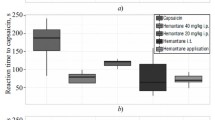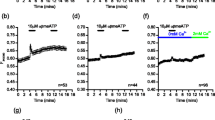Abstract
(D-Pro4 D-Trp7,9,10)SP4–11 (SPA) has been shown to be a competitive antagonist of the histamine releasing action of substance P in rat peritoneal mast cells. Antagonist activity of SPA is expressed in the concentration range 1 to 10 μM, but at higher concentrations SPA releases histamine.
SPA inhibits the flare response induced by substance P in human skin but is without effect on the wheal response. Up to 12.5 pmol SPA produces neither wheal nor flare response by itself.
The structurally related peptide, kassinin, does not cause histamine release from rat mast cells at concentrations up to 10 μM whereas the methyl ester of substance P was found to 1.6 times more active than substance P in this respect.
The findings are discussed in terms of the classification of substance P receptors and the mechanism of wheal and flare in human skin.
Similar content being viewed by others
References
J.C. Foreman andC.C. Jordan,Histamine release and vascular changes induced by neuropeptides, Agents and Actions13, 105–116 (1983).
F. Lembeck,Sir Thomas Lewis's nocifensor system, histamine and substance P containing primary afferent nerves, TINS6, 106–108 (1983).
B. Pernow,Substance P — a putative mediator of antidromic vasodilatation, Gen. Pharmac.14, 13–16 (1983).
L.L. Iversen, M.R. Hanley, B.E.B. Sandberg, C.M. Lee, R.D. Pinnock andS.P. Watson,Substance P receptors in the nervous system and possible receptor subtypes, Ciba Fdn. Symp.91, 186–195 (1982).
S. Rosell andK. Folkers,Substance P antagonists: a new type of pharmacological tool, TIPS3, 211–212 (1982).
M.R. Hanley,Substance P antagonists, TINS5, 138–140 (1982).
S.J. Bailey, R.L. Featherstone, C.C. Jordan andI.K.M. Morton, An examination of (D-Pro4 D-Trp7,9,10)SP4–11 as a tachykinin antagonist. InSubstance P Dublin 1983 (EdsP. Skrabanek andD. Powell). Boole Press: Dublin pp. 16–17 (1983).
S. Rosell, U. Bjorkroth, J.C. Xu andK. Folkers,The pharmacological profile of substance P (SP) antagonist. Evidence for the existence of subpopulations of SP receptors, Acta physiol. scand.117, 445–449 (1983).
J. Mizrahi, E. Escher, S. Caranikas, P. D'Orleans-Juste andD. Regoli,Substance P antagonists in vitro and in vivo, Eur. J. Pharmac.82, 101–105 (1982).
J.C. Foreman, M.B. Hallett andJ.L. Mongar,The relationship between histamine secretion and 45 calcium uptake by mast cells, J. Physiol.271, 193–214 (1977).
P.A. Shore, A. Burkhalter andV.H. Cohn,A method for the fluorimetric assay of histamine in tissue, J. Pharmac. exp. Ther.127, 182–186 (1959).
C.M.S. Fewtrell, J.C. Foreman, C.C. Jordan, P. Oehme, H. Renner andJ.M. Stewart,The effects of substance P on histamine and 5-hydroxytryptamine release in the rat, J. Physiol.330, 393–411 (1982).
J.C. Foreman, C.C. Jordan, P. Oehme andH. Renner,Structure-activity relationships for some substance P-related peptides that cause wheal and flare reactions in human skin, J. Physiol.335, 449–465 (1983).
G.F. Erspamer, V. Erspamer andD. Piccinelli,Parallel bioassay of physalaemin and kassinin: a tachykinin dodecapeptide from the skin of the African frog Kassina senegalensis, Naunyn-Schmiedeberg's Arch. Pharmac.311, 61–65 (1980).
J.C. Foreman, C.C. Jordan andW. Piotrowski,Interaction of neurotensin with the substance P receptor mediating histamine release from rat mast cells and flare in human skin, Br. J. Pharmac.77, 531–539 (1982).
C.-M. Lee, L.L. Iversen, M.R. Hanley andB.E.B. Sandberg,The possible existence of multiple receptors for substance P, Naunyn-Schmiedeberg's Arch. Pharmac.318, 281–287 (1982).
P.R. Gater, C.C. Jordan andD.G. Owen,Relative activities of substance P-related peptides in the guinea-pig ileum and rat parotid gland, Br. J. Pharmac.75, 341–351 (1982).
M. Cascieri, M.M. Goldenberg andT. Liang,Biological activity of substance P methyl ester, Molec. Pharmac.20, 457–459 (1981).
Author information
Authors and Affiliations
Rights and permissions
About this article
Cite this article
Piotrowski, W., Devoy, M.A.B., Jordan, C.C. et al. The substance P receptor on rat mast cells and in human skin. Agents and Actions 14, 420–424 (1984). https://doi.org/10.1007/BF01973842
Issue Date:
DOI: https://doi.org/10.1007/BF01973842




